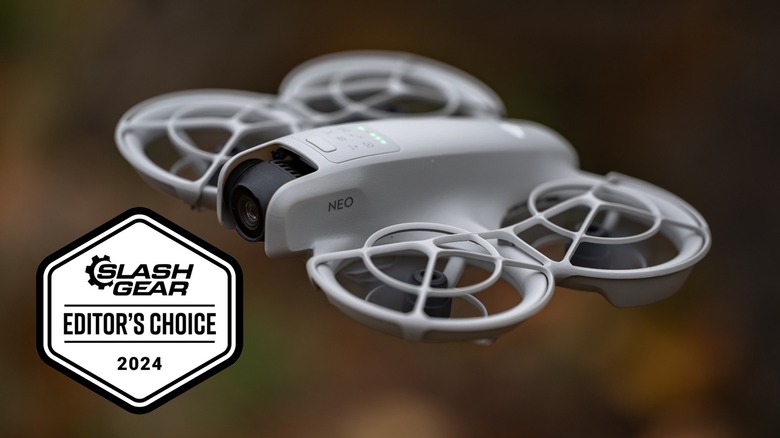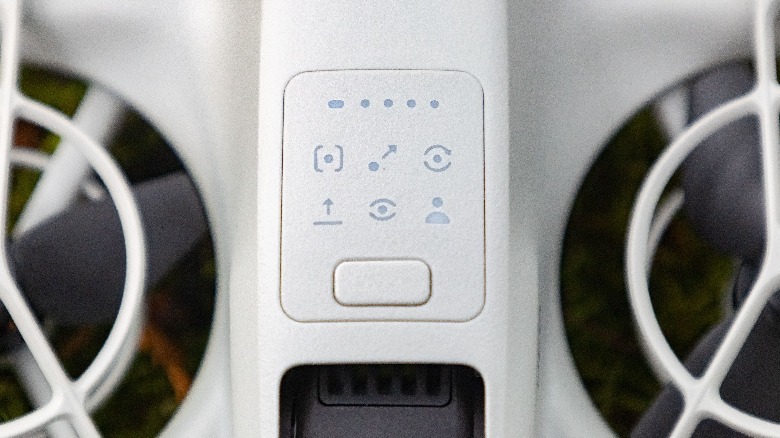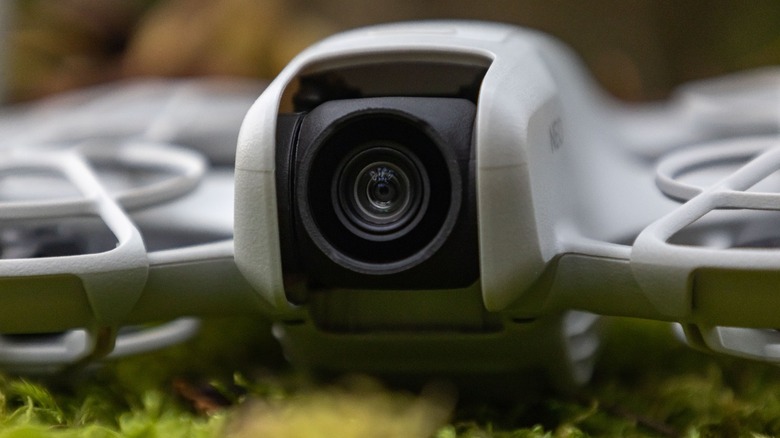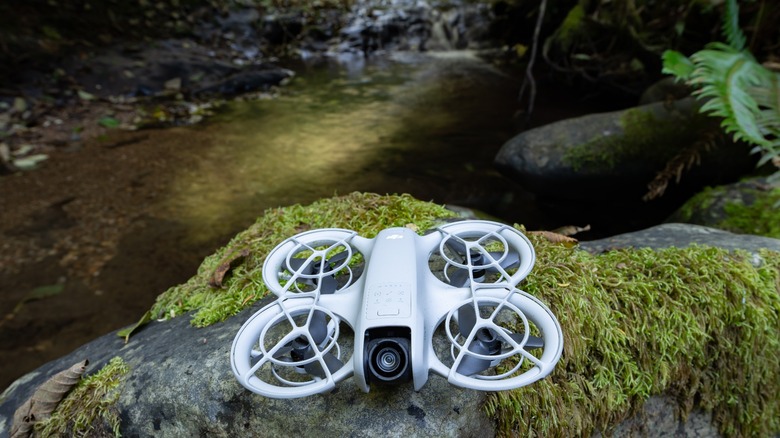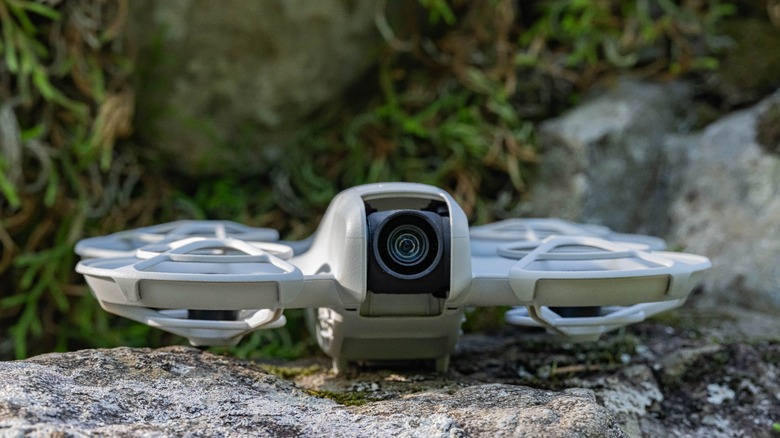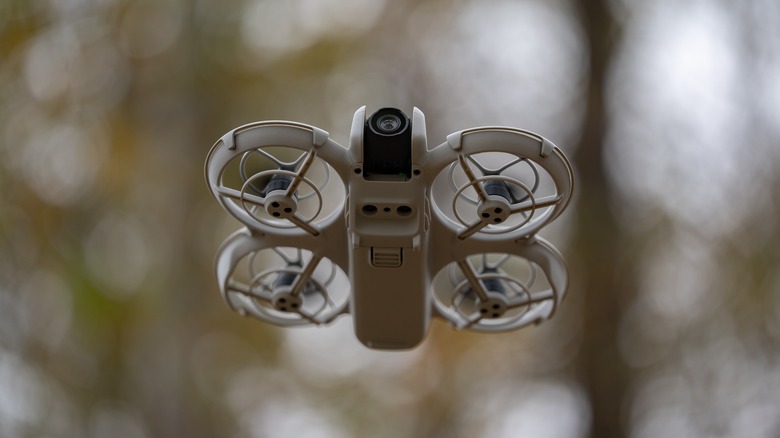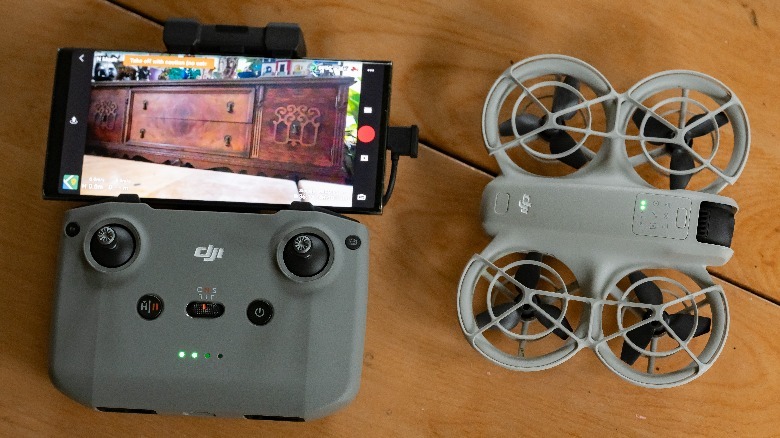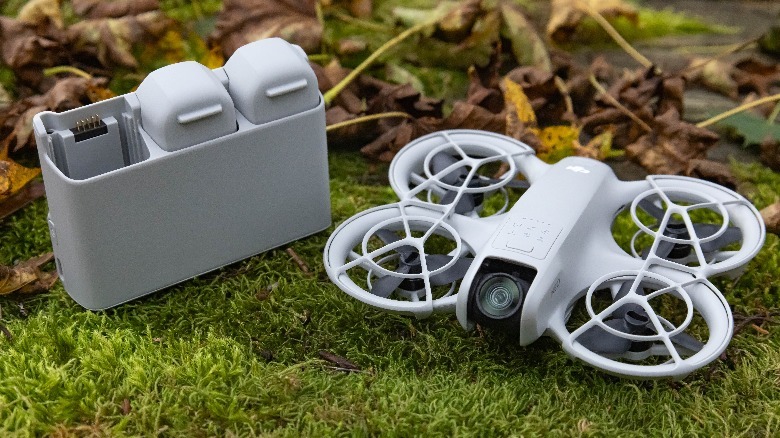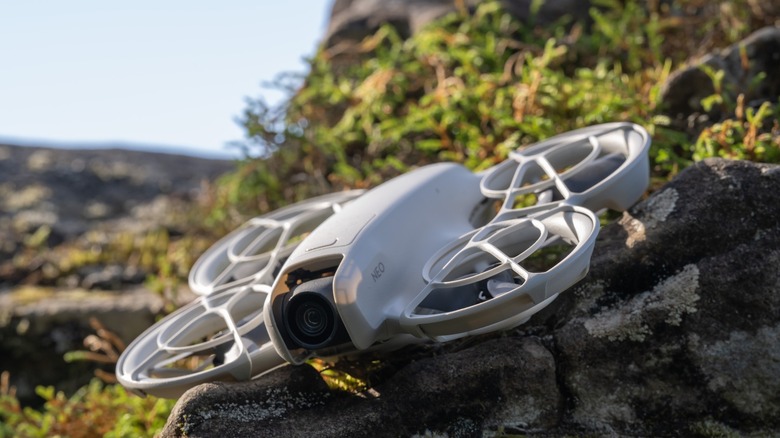DJI Neo Review: The Best Low Price No-RC Starter Drone Yet
- Easiest drone to pick up and fly
- Inexpensive
- Subject tracking and obstacle avoidance are shockingly effective
- More advanced operation possible through optional accessories
- Relatively safe to fly thanks to built-in propeller guards
- Light weight and small size are regulation and travel friendly
- Video quality isn’t the greatest
- Unreliable when flying over water
We may receive a commission on purchases made from links.
The dream of an affordable drone which doesn't require direct user control has long been often promised but never fully delivered — until the DJI Neo. The Neo is available at a remarkably low starting price (for around $199 on Amazon) and in theory can operate without being connected to a controller or a phone. For more advanced users, the Neo is designed to work with optional controllers and headsets, so it can be more than just a selfie-drone. It's also small, and lightweight enough to skirt the more stringent regulations which apply to large/heavy drones.
Despite being affordably priced, it is nonetheless equipped with a camera capable of capturing 4K video footage. Typically, I'd be skeptical of a cheap drone promising such capability, but this is DJI, so there's a good chance that what's promised on paper may turn out to be true. It must also be seen how good its tracking and obstacle avoidance can be without the aid of the normal sensors that more expensive DJI drones are equipped with. In order that we would be able to test everything out, DJI provided the Neo for this review.
Easy to fly, even for beginners
Modern drones aren't typically very challenging to fly, but there is a learning curve to flying something like the DJI Mini 4 Pro or the DJI Avata 2. They make things simple, but there are still controls to learn and you've got to use a controller of some sort with them. Once activated through the DJI Fly companion app, the DJI Neo is ready to fly at a moment's notice with no additional tools needed. Just place it on your palm, power it on, select from one of a range of preset flight modes, and hold down the mode button to take off. The drone will do its thing and then return, whereupon you hold out your hand and it automatically lands.
Admittedly, I've been hand-landing drones for a very long time, as typically the places I fly don't have the necessary flat ground, but with other drones it's a tricky maneuver made somewhat hazardous by exposed propellers. With the Neo, the prop guards make it safe to take off and land on your hand, and it's truly impressive how it never failed to sense my palm and land perfectly in it. There has never been a more accessible drone, with the barrier to entry being so low as to be practically nonexistent.
It's also possible to manually control the drone via your phone, or there are several compatible controllers you can buy to use with the Neo, depending on how you prefer to fly it. It's even compatible with the DJI Goggles 3 (the latest version of DJI's FPV drone headset/goggles/viewer system), so in addition to being incredibly easy to fly, it's also versatile and capable of being used for more advanced purposes. Battery life is around 18 minutes of flight time, which is decent.
Image quality is good enough
The video footage captured with the Neo isn't exactly amazing compared to what you'll see from one of DJI's more advanced drones like the Air 3, but it gets the job done. The 4K footage is reasonably crisp, even though you can tell it's being captured with a ½-inch sensor, which is smaller than you'd find in other modern DJI drones, but it's good enough that I find it usable in conjunction with footage from other cameras I might use in one of my video projects.
Think of it a bit like an action camera, where it's more about the special aspects of the camera that allow you to capture than the quality of image which the sensor can provide. In the case of the Neo, much like an action camera I can fit it in my pocket, which means I'm more likely to have it with me and get the shot. I'm also more likely to fly it because of how quick it is to get in the air, and then to have it instantly follow me around is a functionality I've never had such convenient access to in other drones.
It's also important to keep some perspective with the image quality delivered by the Neo. Compared to my first drone, the DJI Spark, footage from the Neo looks spectacular. The Spark could only shoot in 1080p 30fps, and at just 7 years old isn't exactly ancient, so by comparison the Neo's camera is a huge step up.
Astonishing obstacle avoidance and subject detection capability
When I first sent the Neo up to follow me running off-trail into a dense subalpine forest, I fully expected the little drone to end up flailing amongst the ferns or lost and confused by branches and bushes. In other words, I expected to have to come to its rescue as I have so many FPV drones. However, to my surprise, not only did the Neo remain airborne (it never once crashed during my time testing it), but it was surprisingly hard for me to confound it enough to break its tracking lock on me.
Subject tracking locked onto me every time within seconds of takeoff, and stuck to me like glue. I found that the only way to break tracking with the default settings was to abruptly dodge behind a tree, and even then I had to be quick about it. Running flat-out down a narrow trail through brush and thick trees, the Neo was able to maneuver flawlessly, only losing tracking once.
Tracking isn't fool proof
I brought the DJI Neo along on one of my expeditions out into the remote groves of wild forest which may still be found hidden in the hills of Southwest Washington, which was the perfect place to test the limits of its tracking and obstacle avoidance systems. As it turned out, this also turned into an unintentional durability and water resistance test.
In open fern-filled glades beneath tall trees, there was no problem, and even in denser patches where the boughs crowded close about me it was generally reliable. However, where I had to squeeze through narrow gaps between the trunks of towering doug firs, or duck beneath a low hanging branch, it had a tendency to lose track. This shows how sudden loss of subject visibility can break tracking, and it should also be noted that the drone did not do so well at avoiding obstacles when wind caused trees and shrubs to move around erratically. Lightweight drones tend to be less resilient to wind and less stable in the air, and the Neo is no exception.
A durable little drone
While out in the deep woods I crashed the Neo several times, and thankfully it survived without a scratch thanks to the durable construction and propeller guards. Fine moss dangling from trees seemed to be a particular nemesis, and when I was on top of a mountain with high wind it got tossed into the bushes a few times.
The most concerning flaw I encountered seems to be how the Neo's downwards sensors seem to be easily confused by water. I took off and flew over a small creek, intended to fly through the large gap under a gigantic fallen tree. However, the drone behaved erratically, and ended up tumbling into the water. I leaped up and grabbed it in under 3 seconds, but was very concerned because the Neo is definitely not water resistant. I immediately powered down and removed the battery, wiped it down, then shook as much water as I could get out of the various crevices. I then carried it for the rest of the trip in my hand so that it would dry out.
Fortunately, the Neo doesn't seem to have suffered any ill effects from its brief immersion, though I don't recommend repeating my unplanned waterproofing and underwater video test. In general, this is an impressively robust device, just be careful when flying around bodies of water.
A real bargain
At just $199, the Neo finds itself not competing with major brands, but with cheap drones of dubious quality from no-name brands on Amazon. It's almost half the price of the Gleesfun G11Mini which I reviewed earlier this year, and that drone is almost unusable. In its class it's unmatched, though the picture becomes a little less clear once you add the DJI Controller N3 which I tested with the Neo.
That controller will set you back an additional $129 (if you purchase the N3 controller from Amazon), making the minimum cost to use the Neo as a "normal drone" a total of $328. That puts it very close to the DJI Mini 3 which includes a controller, has a larger image sensor, and is overall a more capable drone for $419 from Amazon. If you pick up the Neo with the DJI RC Motion 3 ($99) and the DJI Goggles 3 ($499), then the total comes in just slightly under the $845 base price of the DJI Avata 2.
It also needs to be mentioned that I tested the Neo with the optional DJI Neo Three Battery Combo. This includes two spare batteries and a charging hub, and adds an extra $90 to the price of the Neo. I usually recommend getting the Fly More combo with DJI drones, as you will almost certainly end up purchasing extra batteries later — at this time there is no "Fly More" combo proper, just what's called this "Three Battery Combo" — we'll expect that a Fly More combo (if it does eventually exist) will include a controller, too — we shall see. With the Three Battery Combo you save $25 over the cost of the batteries and charging hub if you were to buy them separately. The DJI Neo Three Battery Combo is available now for $289.
The upshot is that the DJI Neo is a fantastic deal at $199, but becomes significantly less compelling from a value perspective when you start adding accessories. The compatibility of the drone with so many accessories is more an advantage for current DJI drone pilots who might be interested in adding the Neo to their bag.
Conclusion
There's never been a drone as accessible as the DJI Neo, both in terms of its control options and its base price point. If you just want a drone to film yourself on your adventures, it's pretty much perfect, and thanks to its small size, light weight, and durability, there's an argument to be made in its favor over much more expensive drones. I can throw the Neo in my pocket and take it with me as I would my smartphone, meaning that I'm more likely to have it on me for spontaneous opportunities.
Keep in mind that you won't get the same high image quality with the Neo as a DJI Mavic drone, or even an Avata or Mini, but then that really isn't the point. Like with an action camera, image quality isn't paramount – it's getting the shot that counts. As someone who regularly uses bigger and fancier drones, the DJI Neo is something which fits into my workflow for its portability and convenience. It doesn't waste my time. For novices, it's the perfect first drone with a gentle learning curve and the potential to up your skills over time, all while minimizing risk.
The DJI Neo is available from Amazon or DJI's own online store for approximately $199 and the Three Battery Combo can be had for $289.
